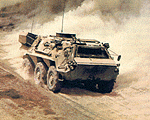
In 1993 a Marine veteran of Desert Storm believed exposures to chemical warfare agents during the Gulf War caused the severe medical problems he was experiencing.[2] He asked several Marine nuclear, biological, and chemical (NBC) defense specialists to make statements about any wartime chemical warfare agent detections or exposures they suspected. In 1993 and 1994 several Marines testified before Congressional committees and in 1994 the Marine Corps initiated an investigation to examine the circumstances surrounding this veteran's possible exposures. The investigation concluded the Marine was not exposed to chemical or biological warfare agents during Operation Desert Storm.[3]
Gunnery Sergeant (GySgt) George Grass provided a statement for the Marine Corps' investigation on behalf of the ill Marine. During the war GySgt Grass served as a US Marine Corps NBC defense specialist and commander of an XM93 Fox Nuclear, Biological, and Chemical Reconnaissance Vehicle, hereafter referred to as the Fox (Figure 2). He also testified before the House of Representatives Government Reform and Oversight Subcommittee (December 1996) and the Presidential Advisory Committee on Gulf War Veterans' Illnesses (PAC) (May 1996 and May 1997) about several suspected chemical weapons incidents during the Gulf War about which he personally knew. On each occasion GySgt Grass discussed several specific MM-1 Mobile Mass Spectrometer (MM-1) alerts for chemical warfare agents, including three at an ammunition supply point (ASP) located southwest of Kuwait City, Kuwait (Figure 3).[4] The MM-1 is the primary chemical warfare agent detector in the Fox vehicle. Information about these incidents also appeared in the June 1997 MITRE Corporation draft report, "Iraqi Chemical Warfare: Analysis of Information Available to DoD,"[5] and in at least one book about the Gulf War.[6]
The Persian Gulf Illnesses Investigation Team, the office supporting the Special Assistant's predecessor, initiated an investigation of these incidents. We completed the investigation and published an interim narrative on September 23, 1997.[7] The Presidential Special Oversight Board for Department of Defense Investigations of Gulf War Chemical and Biological Incidents (PSOB) reviewed the interim report, agreed with our assessment, and in July 2000 recommended that we consider the investigation complete. We amended the interim narrative to address issues the PSOB raised (see Tab E) and now publish this narrative as a final report.[8]
B. Tactical Situation and Force Organization
On February 24, 1991, US Marines launched an offensive into Kuwait to dislodge Iraq's occupying forces. The 1st and 2d Marine Divisions, ground maneuver elements of the I Marine Expeditionary Force (I MEF), were to attack through (breach) two heavily defended minefield belts,[9] advance past Al Jaber Air Base, taking key sites along the way, and converge on Kuwait City to liberate the capital (Figure 3). The 1st Marine Division (1st MARDIV) consisted of units from the 1st Marine, 3d Marine, 7th Marine, and 11th Marine regiments, as well as units from other Marine regiments attached to the 1st MARDIV. For the ground war, the 1st MARDIV was further organized into Task Forces (e.g., Task Forces Ripper and Papa Bear), tailored or task-organized collections of forces drawn from various units and built around a core combat team (e.g., an infantry regiment).[10]
Figure 3. Key locations in the 1st MARDIVs area of responsibility.
The 7th Marine Regiment was the core of Task Force Ripper (Ripper), which consisted of the 1st Battalion, 7th Marine Regiment (the 1/7); the 1st Battalion, 5th Marine Regiment (the 1/5); and the 3d Tank Battalion. Forces from the 1st Combat Engineer Battalion, the 3d Assault Amphibian Battalion, and the 3d Battalion, 11th Marine Regiment (the 3/11) augmented and supported Ripper.[11] In addition, the 1st MARDIV assigned one of its four Fox vehicles, commanded by GySgt Grass, to Ripper.[12] Ripper, the Fox, and the 1/5 are highlighted in the organizational chart (Figure 4) because unit personnel directly participated in operations at the ASP.
Figure 4. Task Force Ripper organization and the chain of command up to I MEF
At approximately 7:00 AM on February 28, 1991, the 1st MARDIV's commanding general ordered his units to cease all offensive operations. By then, the 1st MARDIV had captured its objectives around Kuwait City, among them Kuwait International Airport, to the west of which Ripper established positions.[13]
According to GySgt Grass, During the intelligence briefing that morning, it was stated by the S-2 [Ripper's intelligence officer] that the Iraqi's [sic] had established the 3d Armored Corps Ammunition Supply Point just outside of Kuwait City and that sources (Iraqi prisoners) have stated there were chemical weapons stored somewhere within the ammo storage area. I was informed that my task was to do a complete survey of the entire ASP and locate any chemical weapons that may be stored there.[14]
Suspicions of Iraq's chemical weapons capabilities were well founded. Ripper's NBC officer noted that he wouldn't have been surprised to find chemical weapons in the ASP.[15] According to the 1st MARDIV NBC officer, it was standard operating procedure to assume the possibility of chemical weapons in any of Iraq's ASPs.[16]
In post-war testimony before congress, Lieutenant General Carlton W. Fulford, Jr., who as a colonel commanded Task Force Ripper, testified:
We took this threat of chemical involvement very seriously. We had intelligence ... that the Iraqi forces had the potential, had the capability. We [had] the very best NBC equipment that the Marine Corps had in its inventory at that time. And throughout many months in Saudi Arabia, we trained very, very hard on the detection, protection, and decontamination of our forces.[17]
Before the Gulf War, the US intelligence community[18] warned that Iraq had a chemical weapons capability and had used chemical weapons against its own citizens as well as against Iran during the Iran-Iraq War.[19]
| First Page | Prev Page | Next Page |